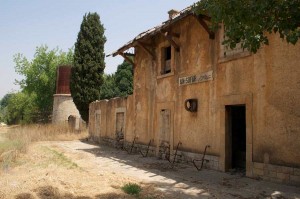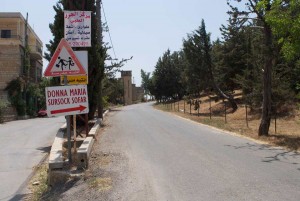On the tree-lined road of Sawfar, known there as the Corniche, there is a relic of the Lebanese past that people have forgotten. When asking my friends about the Sawfar Grand Hotel, most have never heard of it or its story but they know of “that big old abandoned structure off the main road of the town.”
Turns out, in the 60s, Sawfar was the happening place to be for all established families of Beirut as well as the travelers who passed through there thanks to the railway. The Sawfar Grand Hotel was built in the late 1880s by the Sursock family and was the first casino in Lebanon. Because it was built around the same time the train station was opened across the road, travelers taking the Beirut-Rayak line would stop there to stay at the hotel which was notorious for its casino, cinema, and nightclub, the Monkey Bar.
I had always hoped to sneak onto the property and explore solo but the problem with that plan is that you never get the backstory right. You don’t know who walked the halls before you, who danced on the broken tiles under you, or who fell in love in the courtyards around you. Without the story, these structures remain unidentified bodies in the morgue, rotting down to the bone. They’re still part of what once was but they’re less human and you don’t know who they were when they were alive.
After finding out that the property was owned by the Sursocks, I got in contact with Roderick Cochrane, the youngest son of Lady Cochrane and grandson of Alfred Sursock. He was surprised I hadn’t already been to the hotel but even more flabbergasted that I was asking for permission to access the property first. That’s just not how things are done in Lebanon when it comes to the abandonment of our historical gems. Rarely do you find people who even pay attention to their existence, let alone respect their boundaries.
The hotel itself was never managed by the Sursock family and had various families (Tueni, Najjar, Rihani) renting it over the years. Government officials, Saudi kings, and other foreigners would take up residence at the hotel because it was a place they could easily get to and comfortably speak in Arabic. No need to fly to Europe. Apparently, the restaurant was a draw as well; George Rayess, the first Lebanese chef to publish his own cookbook, was a cook there.
It closed once the civil war of ’75 broke out but Roderick says that business started to dwindle a few years before that because of the proliferation of air conditioners in Beirut. Summers were bearable and less people made the trip to mountain getaways by then. After closure, it was the headquarters for the Syrian army who also contributed to the damages of war by stripping the wooden beams from the roof and burning them for warmth as well as dragging the elevator engines down the stairs, creating deeper gashes in an open wound. It, along with the Sursock’s villa there, suffered through the war and was looted by inhabitants and militias. And so, like all hotspots of Lebanon, the hotel’s heyday was in the 1960s. The more I find out about our past, the more I find myself wanting to have a Midnight in Paris trip to the days when our country was more advanced than it is today. We all seem to be enamored with the fantasy that is now long gone.
When asked why the Sursock family seems so adamant about preserving old Beirut, he replied, “It’s a special mentality. Although the Sursock money came from being merchants of cotton and wheat and things like that – things have changed. We don’t operate in that vein anymore. We don’t have money in the banks, we have it in properties.” Both villas’ gardens are used as venues for weddings and private events now. However, Roderick’s attachment to the properties is more sentimental than economical. He lives in the Beirut villa and spent childhood summers in the villa of Sawfar, named Donna Maria after his grandmother. He says,“it’s about family. If we lose our properties little by little, what will be left of us?”
When it comes to saving what is left of our architecture and history, we have no one to blame but ourselves. Laws have not changed, corruption continues, towers rise. “The Lebanese are merchants, they think about profits. They don’t think about the future. They forget about the past and they don’t think about what’s got to be good for their descendants or what country they’re going to leave for them.” Sighs all around.
Roderick seems to have hope in the younger generation when it comes to change though. He senses their anger and understands their frustration, but commiserates with those who leave for better opportunities. “You have to survive,” he says. He notes how most who stay behind only do so to inherit family businesses since typical salaries aren’t the numbers you can build a life with.
After meeting him and talking about his family’s legacy, work toward preserving Lebanese heritage, and the summers in spent in the town above Aley, Roderick granted me my wish of visiting Sawfar and advised me to “park my car at the villa and take a stroll down through the Corniche past the gendarmerie, down to the hotel across from the train station.” He also informed me that Lady Cochrane was spending her summer in the renovated servant’s quarters of their old villa and that she’d love to have a chat. A chance to talk to the woman who was there throughout the glory days of the country and started APSAD, a foundation for saving our heritage in the 1960s? Roderick was suddenly my genie and I was already somersaulting on a magic carpet.
The delicate woman spoke of the peak of Sawfar’s summers when she was young and how things have transformed since then. Less people visit villages, more people moved to the city, and the spirit of the youth has slowly evaporated. The house had an esplanade where her mother made a floor for dancing and, before she was born, her father planted all the trees along the Corniche, the trademark of Sawfar’s main road. She says, “it’s one of the only villages that hasn’t been spoilt by concrete.”
Lady Cochrane’s family is a multinational smorgasbord. Born in Naples to a Lebanese father and Italian mother, married to an Irish nobleman, and relations to French, American, and Canadian in-laws, it is quite the compliment for such a worldly woman to say that “Lebanon was one of the most beautiful countries you can think of when I was young. Beirut, you would never believe it but, Beirut was simply beautiful, one of the most beautiful cities of the Mediterranean.” After all, she would know.
As she speaks, I can’t help but feel guilty for not pumping my own grandmother for stories like this. She’s 10 years younger than Lady Cochrane (who’s 93) but doesn’t reminisce; she’s more concerned with electricity cuts of the present. As if she heard my thoughts, Lady Cochrane then mentions her plans to have windmills installed in Sawfar so the village can have an alternative electricity supply. She may be aging, but she’s still leveraging her influence. On top of that, she studied town planning for 7 years but never got her degree because she couldn’t make the last term move abroad since she was married with children by that time. “We’ve ruined our mountains, our cities, everything. We should make an island and put all the skyscrapers there and rebuild Beirut the way it was before. We create Beirut as it was, with lovely buildings and green spaces.” So who’s got a spare island? Maybe Dubai can lend us one and we can supply the towers.
“Everything good in Lebanon was suppressed. But there it is, we still have a few places left in the mountains.” She feels it’s too late to save what is left of Beirut; I hope, for Lebanon’s sake, that she’s wrong.
First posted on the blog Bambi’s Soapbox [5], by Farrah Berrou in Beirut.

